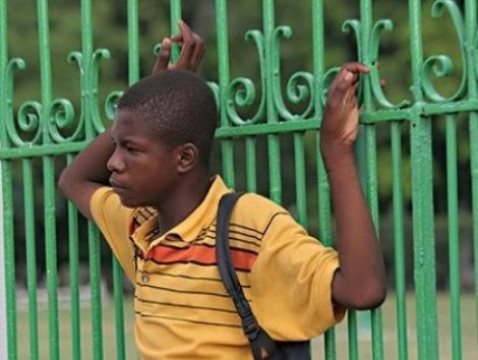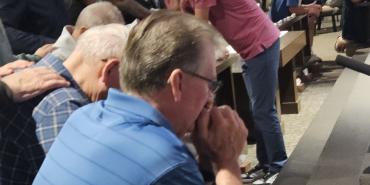Haiti in Transition

It's almost impossible to get to the site where Samarite Dessuisseau has convened this meeting.
The road, if you can call it that, is dirt, gravel, boulders, dry river beds, hard right turns, and harder left turns. Make sure you have enough momentum going to make it up the final steep climb. Few cars, trucks, or vans can make it. Bring extra tires. If you can, use a rental vehicle and leave your own back home. Motorcycles can do it. Most people walk. It's a hard road that's been under construction for a long time.
Dozens of local leaders are at this meeting in a community called Cascade Pichon to report their progress, despite the difficult road.
The meeting place is a deck overlooking a spectacular valley, and a perfect view of one of Haiti's natural wonders, a waterfall that comprises 100 streams spilling down the side of a mountain fed by an underground lake.
The main agenda item for the meeting is the cholera epidemic. Hundreds in nearby communities have died from the disease. Just a week before the meeting, in a shelter a few hundred feet away, cholera killed five people from the same family. Those at the meeting report progress.
Before the 2010 earthquake that killed more than 300,000 and displaced more than 1 million, this region was largely ignored. The local cell phone company didn?t even build a tower this high into the mountain because it didn?t think enough people lived in the area. How could they without a good road?
But Samarite and his group identified more than 40,000 people living there.
The area has never had a school, access to medical care, or a church. Until now.
Samarite is the Nazarene district superintendent in this region, and president of a federation of nearby business, government, and religious leaders who assess the needs of communities, and then implement a plan to address those needs. With Samarite leading the way, the federation has partnered with non-government organizations, volunteer groups including hundreds of Nazarenes from nearby countries and local residents to develop Cascade Pichon's medical clinic, church, schools, and hotel to accommodate the workers.
The area is so remote and so difficult to reach that much of the material needed for these facilities had to be carried by hand the final mile up steep, rocky terrain. Even the examination tables for the medical clinic, which weigh hundreds of pounds each, had to be lumbered up the final hill by exhausted volunteers. Construction on the road continues slowly, but surely.
Samarite was educated at the Nazarene Bible College in Port-au-Prince, and pastored churches in the area. When he became superintendent of the Southeast District in 1990 there were 13 Nazarene churches in his district. Now there are 35, with more than 5,000 members. As a pastor and district superintendent, he knew that ministry needed to be much more than just running a church.
"Being a pastor in my region meant I had to also help provide social services," he said. "We developed places where people could get safe drinking water, healthcare, and education." Next to one of the Nazarene churches near his house in the city of Bleck is a medical clinic and a school.
One of Haiti's main exports to Europe is coffee, and Samarite organized a coffee cooperative with local growers, which provided jobs and higher wages for workers. Now, several hundred coffee growers are in the co-op. He is organizing a second co-op with more than 700 growers.
Samarite has also organized efforts to reforest sections of his region. Much of Haiti's forest has been cut down for people to use the wood for cooking and heating, which has created environmental problems throughout the country. Thousands of trees have been planted through the efforts of the federation Samarite leads.
"He is tireless," said Steve Weber, a former Nazarene missionary in Haiti who now oversees the work in Haiti for Heart to Heart International, a humanitarian aid organization. Heart to Heart worked with Samarite in developing the clinic in Cascade Pichon, as well as medical clinics throughout the southern part of the country. "The reason Heart to Heart is such a good fit with Samarite is that he sees himself as a pastor with an eye for all of his community's needs. He's committed to their salvation, as well as to their health, education and economic development," Weber said
A similar whole-person effort is underway in the country's largest city, Port-au-Prince. The Bel Air Church of the Nazarene has seen significant changes in recent years. It used to be surrounded by a middle-to-upper-class neighborhood and was one of the strongest churches in the country. In recent decades, though, with Haiti's economic decline and devastation from natural disasters, the neighborhood has become full of crime and gangs. The church has adjusted its ministries to meet the times.
When the 2010 earthquake struck, the church became a major site for treating the injured and sick, partnering with Heart to Heart as well as other organizations. Now, more than three years later, the top floor of the church building is still a medical clinic and is busy morning and night.
"The earthquake changed the paradigm of the church," said Walliere Pierre, pastor of the Bel Air church for 22 years. "We developed many more ministries after the earthquake and became more of a church of social action."
Pierre developed an anti-gang program through the church, where hundreds of young people come for spiritual teaching and vocational training. They are learning skills in construction, plumbing, electrical engineering, and computers, all necessary for the country to rebuild.
"We are putting the church in service to the community," he said. "That means we are addressing the spiritual, social, economic, and governance needs of our people. God is clearly at work in what we are doing. I see hope every day."
So does Weber. He is seeing educated Haitians who had left the country now returning home to participate in the nation's future. "It isn?t the missionaries or the non-government organizations that are making the biggest difference now. It is the Haitians," he said. "God is moving in ways we have not seen before."
Mary Orjala, with her husband, Paul, was a missionary to Haiti in the 1950s and 60s. She was pleased to hear about the work being done there now.
"Paul was always trying to develop leaders," she said. "That's what his missionary work was all about."
It's another road that's been under construction for a long time.
Dean Nelson is director of the journalism program at Point Loma Nazarene University.
Holiness Today, 2013
Please note: This article was originally published in 2013. All facts, figures, and titles were accurate to the best of our knowledge at that time but may have since changed.




